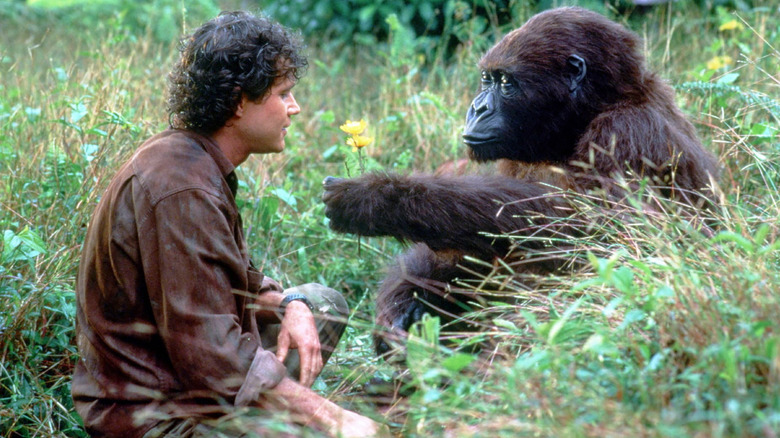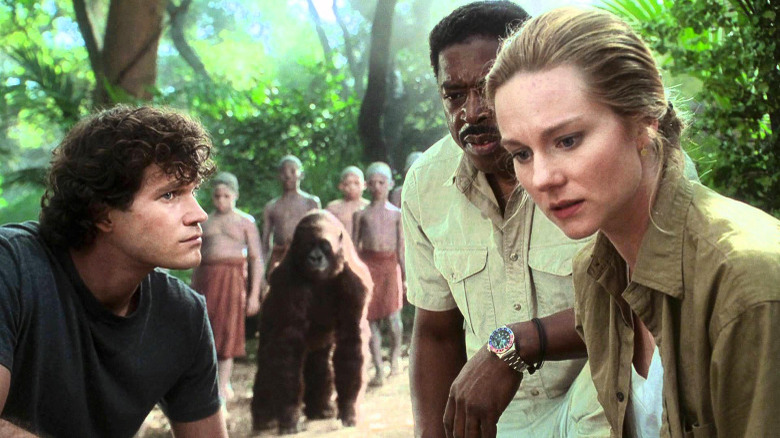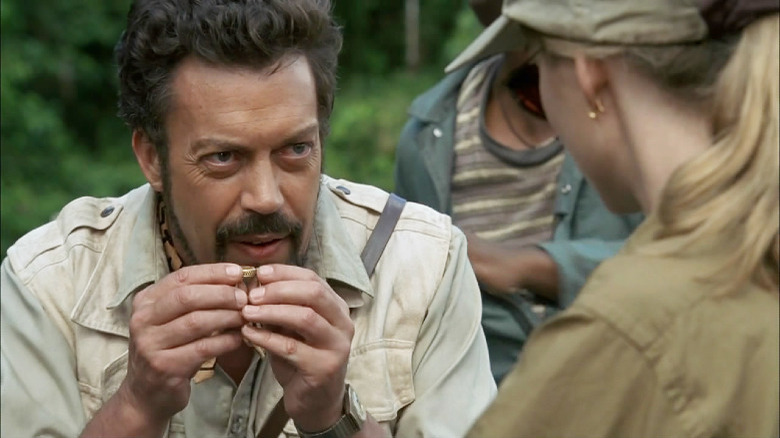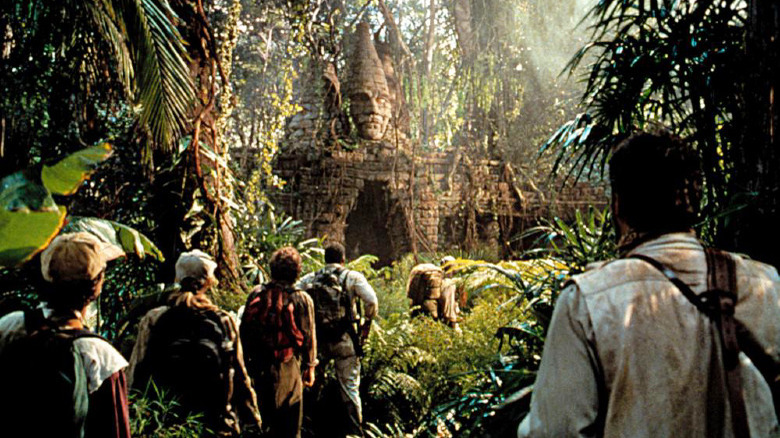In Defense Of Congo, Jurassic Park's Weirdo Cousin
After director Steven Spielberg's "Jurassic Park" took the world by storm in 1993, studios did what they always do when a film captures lightning in a bottle: Try and replicate its success while changing the original formula as little as possible. The only problem? "Jurassic Park" author Michael Crichton didn't have a bunch of extra dinosaur novels lying around, waiting to be adapted, and had only just begun to write his sequel book, "The Lost World." What he did have was "Congo," a 1980 novel he had written as a throwback to Victorian-era stories about adventurers uncovering the remnants of long-lost civilizations (with H. Rider Haggard's 1885 Allan Quatermain book, "King Solomon's Mines," being the main inspiration).
Crichton had actually written "Congo" as part of a deal he made with 20th Century Fox to develop his story idea into a novel and script at the same time. After plans fell through for Crichton to direct the film version with Sean Connery starring (which would've reunited the duo after their previous work together on 1978's "The Great Train Robbery"), the screen rights found their way over to Paramount Pictures. Not wanting to miss a chance at making its own "Jurassic Park," the studio hired "Indiana Jones" and "Back to the Future" producer Frank Marshall to call the shots from an adapted script by Oscar-winning scribe John Patrick Shanley.
What could go wrong? Well, a lot, it turns out. "Congo" made $152 million on a $50 million budget, but left both critics and general audiences unimpressed and failed to have anywhere near the impact of "Jurassic Park" upon its release in 1995. And yet, here I am defending it, 27 years later. Why? Because "Congo" is far stranger and more interesting than its reputation as a Spielberg-lite action-adventure would suggest.
This is pure Kafka
On the surface, the plot of "Congo" is pretty simple and centers on an eclectic group of people on an expedition deep into the Congo jungle. But at the same time, it also involves a mountain gorilla, Amy, who communicates by using a high-tech glove that translates her signing into a digitized voice, a bunch of mysterious, violent grey gorillas, a rare diamond that a tech company, TraviCom, wants to use to power its cutting-edge communications laser, and a fabled location called the Lost City of Zinj.
Even with so much happening (a lot of it silly), "Congo" is never confusing so much as, well, quirky. It's a film that begins with a character played by Bruce Campbell in the Congo jungle, which should really be your first clue not to take what you're watching too seriously. The movie's first big scare is equally hokey, culminating in a shot of someone screaming as they look almost directly into the camera. If that sounds familiar, it's because Steven Spielberg used that exact same trick in "The Lost World: Jurassic Park" two years after "Congo," albeit followed by a perplexing smash-cut to Jeff Goldblum yawning.
"Congo," in a sense, is like if that smash-cut was somehow able to mutate into an entire movie. The film sprinkles tongue-in-cheek moments and off-beat humor (like an interrogator completely misunderstanding a reference to Franz Kafka) amidst far more serious action scenes and intense moments involving airplanes, angry hippos, an exploding volcano, and the aforementioned killer apes. Is it trying to be thrilling, funny, or both? The answer is "yes," in the same way "Jurassic Park" so often manages to nimbly switch tones, sometimes within a single scene. Yet, "Congo" performs this balancing act in a much more idiosyncratic and fascinatingly head-scratching style.
Stop eating my sesame cake!
Much of the inspired weirdness in "Congo" can be traced back to John Patrick Shanley. True, Shanley wrote the 1993 true story-based survival drama film "Alive" (which Frank Marshall also directed) and won both a Pulitzer and Tony for his 2004 stage play "Doubt: A Parable," both of which are quite weighty. At the same time, he's also the storyteller who gave us the 1990 cult comedy "Joe Versus the Volcano," justly won an Oscar for penning the swooning rom-com "Moonstruck," and wrote the decidedly bizarre '90s animated movie "We're Back! A Dinosaur's Story."
Shanley, in other words, is very eccentric (see also: his amazingly horny tweets), so it's no shock he amped up the absurdity inherent to the "Congo" novel while injecting some rather odd comedy into his adapted script. This also feeds into the movie's acting, with a hilarious Tim Curry devouring the scenery as Herkermer Homolka — a Romanian "philanthropist" who resembles a live-action "Rocky and Bullwinkle" villain — and Ernie Hudson having a blast channeling Clark Gable as Monroe Kelly. "I'm your Great White Hunter for this trip though I happen to be Black," he says in his first scene, somehow being both effortlessly cool and utterly ridiculous in one fell swoop.
Speaking of effortlessly cool, that's exactly what Laura Linney is as ex-CIA-turned TraviCom employee Karen Ross, who gets to play both the action hero and straight (wo)man while her costars camp it up. That is, save for Dylan Walsh as kindly primatologist Peter Elliott, whose subversive dynamic with Karen finds him in constant need of saving and not the other way around. And, of course, any discussion of "Congo" would be incomplete without singing Delroy Lindo's praises for his zany, uncredited turn as Captain Wanta, an aggressively polite Ugandan military officer.
Bad apes + crystal lasers = cinema
Among the film's defenders in 1995 were Roger Ebert, who likened "Congo" in his review to "one of those movies like 'Beat the Devil' that is a put-on of itself. The result is not a movie that is very good, exactly, but it's entertaining and funny." That being said, even Ebert would admit there are areas where the movie falls short for reasons other than the sake of kitsch, most notably the action scenes and set pieces. They're still full of evil apes, crystal lasers, and a volcano going kablooey, mind you, but are also far less seamless in design than comparable moments of spectacle in Steven Spielberg's "Indiana Jones" and "Jurassic Park" movies.
As for Michael Crichton's reported dissatisfaction with the film adaptation of "Congo," perhaps Ebert (once again) put it best:
"... ['Congo'] is based on a novel by Michael Crichton, who is said to be unhappy about what they've done with his book. Since it is impossible to imagine this material being played for anything but laughs, maybe he should be grateful."
Honestly, time has been kind to "Congo." The practical gorilla animatronics crafted by visual effects pioneer Stan Winston and the unconvincing CGI lava in the film's climax (which, I can vouch, didn't look good back in 1995 either) only add to its old-school pulpy vibe, as do the cartoonish performances and fanciful touches that John Patrick Shanley brought to the table as a writer. Whatever movie Paramount and Frank Marshall thought they were making, what they wound up producing is much more enjoyable, re-watchable, and otherwise memorable than the other wannabe Spielberg blockbusters and post-"Jurassic Park" Michael Crichton adaptations that flooded theaters back in the '90s.
"Congo" is available to stream on The Roku Channel and various other streaming platforms.



